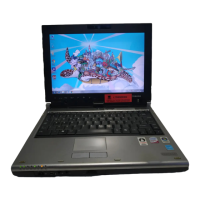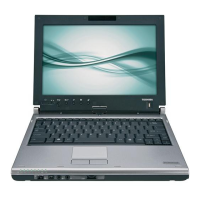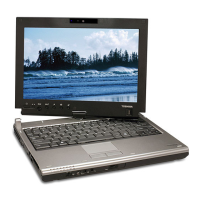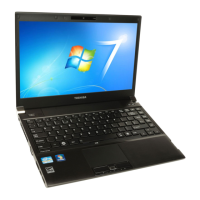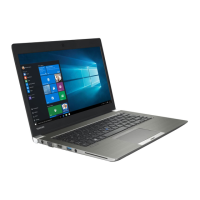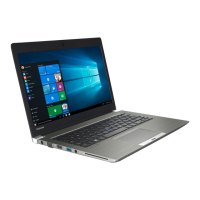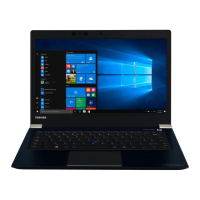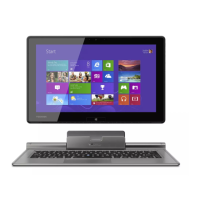
Do you have a question about the Toshiba Portege M780 and is the answer not in the manual?
Explains the formats used in the manual to describe terms and procedures.
Describes how icons are used to identify ports, dials, and other computer parts.
Provides guidance on setting up a safe and optimal workspace for the computer.
Advises on preventing stress injuries related to extensive keyboard use and workspace ergonomics.
Lists the hardware items included with the computer for initial setup.
Provides instructions on how to connect the AC adaptor for power and charging.
Explains how to open the display panel to a wide range of angles for optimal viewing.
Details the procedure for turning on the computer's power.
Describes how to shut down the computer in different modes like Shut Down, Hibernation, or Sleep.
Explains the features and procedures for recovering the system using dedicated options.
Illustrates and labels the computer's front view with the display panel closed.
Identifies and describes components located on the left side of the computer.
Identifies and describes components located on the right side of the computer.
Identifies and describes components located on the back of the computer.
Identifies and describes components located on the underside of the computer.
Explains the function of various system LEDs indicating computer operations.
Describes the computer's hardware components such as CPU, Memory, and Disks.
Details modem, LAN, Bluetooth, and Wireless LAN functionalities.
Highlights unique or advanced features like Hot keys and power management options.
Describes pre-installed utilities and applications like DVD Player and Fingerprint Utility.
Lists and describes optional hardware devices and memory media for expansion.
Explains the different pointing devices available and how to use them.
Provides instructions on operating the computer using the Touch Pad.
Details how to use the Tablet PC Pen and Reserve Pen for screen interaction.
Guides on enrolling and using the fingerprint sensor for authentication.
Explains how to remove and install modules in the Ultra Slim Bay.
Provides instructions on loading and removing discs from optical drives.
Describes how to connect and disconnect the internal modem to a telephone line.
Details the setup and operation of the Wireless LAN network connection.
Explains the basic typewriter keys and their differences from a standard typewriter.
Describes the twelve function keys and their programmed functions.
Details key combinations (FN key + function key) to enable/disable features.
Explains the numeric keypad overlay feature for data input and cursor control.
Details the computer's operating capability based on power source and battery status.
Explains how to interpret power indicators like Battery, DC IN, and Power.
Provides step-by-step instructions for removing and installing the battery pack.
Describes how to set User and Supervisor passwords for system security.
Explains the different power-up modes: Boot, Hibernation, and Sleep.
Provides the procedure to launch the TOSHIBA HW Setup program.
Displays BIOS version and contains Default and About buttons for setup.
Allows selection of the display to be used when the computer starts.
Enables setting the boot priority for starting the computer.
Covers keyboard settings, including Wake-up on Keyboard functionality.
Provides guidelines for effectively resolving computer problems.
Offers simple checks for common issues that might cause serious problems.
Guides users on identifying problems by observing system behavior and clues.
Discusses problems related to computer hardware and attached peripherals.
Covers issues when the computer does not start properly.
Provides checklists for AC power and battery related issues.
Troubleshoots issues related to the computer's internal modem.
Addresses problems related to accessing the Wireless LAN.
Provides information on how to contact TOSHIBA for technical assistance.
Summarizes the computer's physical dimensions including weight and size.
Details the ambient temperature and humidity requirements for operation.
Specifies the power requirements for the AC adaptor and the computer.
Explains how the display controller interprets software commands for screen output.
Describes how video mode settings are configured via the Screen Resolution dialog.
Details the specifications of the Wireless LAN card, including form factor and compatibility.
Explains radio characteristics of the Wireless LAN module, including frequency and range.
Discusses the health implications and safety of Bluetooth wireless technology.
Covers compliance with general, EU, and Canadian regulatory standards.
Lists certification agencies for AC power cords and connectors by region.
Provides methods to start the TOSHIBA PC Health Monitor application.
Explains the procedure for cleaning the computer's cooling module.
States legal footnotes regarding CPU performance variations under specific conditions.
Provides legal footnotes on main system memory usage and allocation.
States legal footnotes on how battery life may vary based on usage and configuration.
Explains legal footnotes concerning HDD capacity definitions and variations.
Provides legal footnotes on wireless LAN transmission speed variations.
States legal footnotes regarding the USB Sleep and Charge function compatibility.
Lists and defines common abbreviations used throughout the manual.
